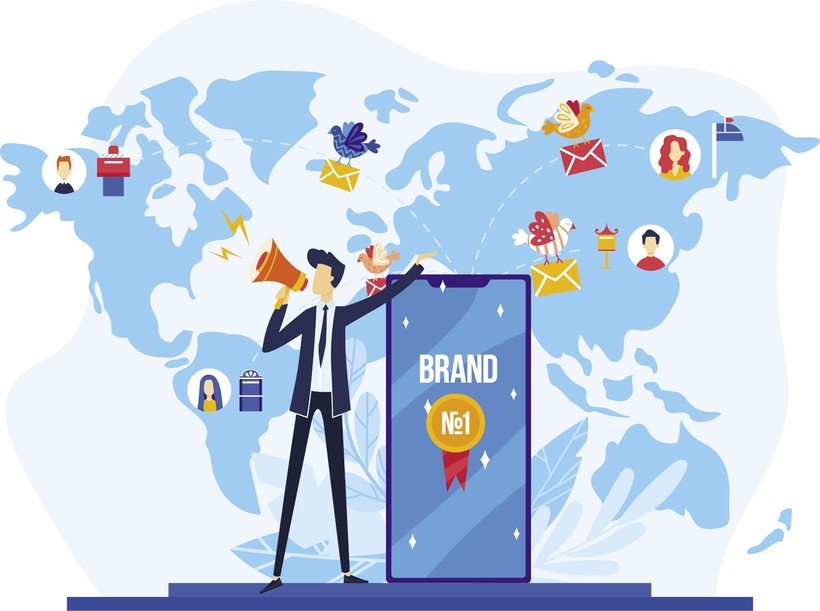WHY THE CHANGE
Consumer-centricity has been a trend shaping
corporate and product strategies for the past two
decades. Its focus on a closed-end system enabling
an all-in-one consumer experience and a marketing
strategy to create an emotional connection with
consumers has contributed to high brand equity
for a company. Brand equity is a premium on the
value a company generates by ensuring its brand
and products are recognised by consumers. In
essence, Apple created a love mark, a brand that
consumers love so much that they are ready to
buy the product despite some redundancies in
performance or quality compared to competitors’
o�erings. Apple is not alone: a similar strategy
has been pursued by companies in many B2C
industries, from Nike, whose landmark Just
Do It campaign created value gains for them,
to Mastercard, whose priceless campaigns and
branding created recognisable catchphrases, and
Google, whose name became a verb substitute for
online queries.
Brand equity and love marks have provided
valuable differentiation for a few decades.
Coupled with functional performance, unique
resources and the capabilities of the companies’
workforce, this has created market leaders and
one of the most valuable companies nowadays.
Yet, this strategy became replicable. Brand
equity could only exist if the consumer’s values
corresponded to the values embedded in the
company’s brand and product positioning.
Corporate growth has created large markets
with numerous consumers. More consumers
means more diverse values. As a result, getting
into everyone’s values with one brand or set of
products has become impossible. On the one
hand, this has created demand for replication
of business models under different brands and
positioning. On the other hand, this has opened
up possibilities for personalisation and more
activities related to customer involvement in the
value chain.
As a result, we are currently facing markets
so diverse and personalised that the world of
products revolves around the customer, who
must be satis�ed. �is starts to spread beyond
hedonistic consumption and starts a�ecting more
functional products as well. According to our
recent research, as of 2021, 87% of consumers in
Russia hold payment cards. Russians are used to
cashless payments.
In addition, the Russian market, alongside those
of India and China, is one of the top three markets
in terms of FinTech adoption, according to EY,
FinTech adoption index 2019. Currently, Russia is
among the top cashless payments markets globally,
especially in contactless payments. BCG has
even named the tremendous contactless payment
growth a ‘Russian miracle’. Even so, this increased
adoption comes at a price for providers. Consumers
know that they are being fought for. According to
our research, consumers are aware they are at the
centre of attention of banks and other �nancial
intermediaries. As a result, consumers get a real say
in these companies’ strategies.
THE LOYALTY REVOLUTION
Market research has become the norm in any
product management and general corporate
marketing. Company managers would usually use
the results of such research to develop products
in response to the pain points and insights
they can pinpoint from the data. What to do
if market research starts to produce con�icting
results and clients cannot be segmented in a
meaningful way? Banks in Russia started to
respond to this by providing a �exible card, where
desired attributes, including loyalty programme
characteristics, can be chosen by the consumer
rather than imposed by the service provider. �is
has gained popularity since about half (47%)
of Russian cardholders currently participate
in loyalty programmes. About half of these
loyalty programme participants (40%) will try
to open a new payment card or switch to cash if
these programmes are suspended or their terms
seriously deteriorate.
Banks are aware of this and respond by providing
loyalty programmes as a baseline option with any
payment card. Tinko� bank went even further by
providing premium-style loyalty programmes to
all its clients.
�e loyalty revolution launched by Tinko�,
which brought loyalty programmes to the mass
market, sparked changes in all the other banks.
Even socially-orientated cards and banks currently
have a version of loyalty programmes in Russia
and consumers are aware of these perks. Some of
them start to use these o�erings for their bene�t, becoming unpro�table users for companies. For
instance, some consumers seek �nancial bene�ts.
�is can take the form of satisfying minimal
requirements to receive bene�ts. In MTS Bank,
a �nancial services provider spun o� from one of
the biggest telecommunication companies in the
country, this resulted in emergence of consumers
who transact the minimum amount for gaining a
free of charge telecommunications subscription.
In banks, this takes the form of transacting just
enough to get a discounted interest rate on loans
or additional interest on deposits.
Overall, 69.3%
of Russian cardholders pursue a �nancial bene�ts
strategy, i.e., use cashless payment instruments
because of loyalty programmes and other rewards,
while about 20% of cardholders (18.9%) use this
strategy as a dominant one, constituting the main
consistent reason for them to participate in the retail
payments market. On the one hand, this means
that �nancial innovations and other marketing
techniques do work for banks: they do attract
more clients. On the other hand, the funding of
such programmes requires s signi�cant funds. Our
latest estimates of the loyalty programme market
across all banks in Russia is about 20.8 billion
rubles ($278.3 million) a month.
According to Kommersant, Sberbank, Russia’s
biggest bank, paid 45.4 billion rubles ($613.5
million) in loyalty programmes in 2020. Tinko�
bank paid about 25 billion rubles ($337.9
million) during the same period. If clients
respond by changing provider a bank’s loyalty
programme deteriorates, we can expect that future
competition will likely increase these costs. Given
that some clients sign up for some bank products
just to qualify for loyalty programme perks, this
creates a problem for existing bank strategies. In
essence, it comes down to the fact the empowered
consumer is strategic and proactive, and any
arbitrage opportunity or loophole can cause
huge losses for organisations. �is trend spans
beyond just the retail payments market. However,
we chose this case since this industry a�ects all
areas of consumer life and was usually considered
utilitarian and functional.
Other industries are
even more dependent on consumers in their
value chain. Sportswear manufacturers provide
customisable apparel to ignite the consumers’
creativity and help them tailor products to
their needs and wants. Platforms such as gig
economy ones (e.g., Uber, Didi, TaskRabbit,
Yandex.Toloka, Yandex.Lavka and Yandex.Taxi,
Citymobil) or sharing economy services (e.g.,
AirBnB) provide users with a range of additional
options (e.g., experience add-ons or customisable
tari�s and requests to drivers) to personalise even
relatively rigid products and services, such as �ats
or rides.
Now it is more essential than ever to
acknowledge customer values.
Apart from the
functional trend toward personalisation and
�exibility, customers also want to consume with
a statement. Being an opportunity for some, this
can become a challenge for others. Companies
like Vkusvill in Russia leverage consumer values
of a healthy lifestyle, trust and local producers’
support to grow successful, pro�table businesses.
On the other hand, a mismatch in values or a
choice of values associated with polarised views
can destroy corporate value. One example is
Nike’s choice of the Dream Crazy campaign
in 2018 featuring former footballer and civil
rights activist Colin Kaepernick. Kaepernick
started kneeling during the national anthem
to protest against racial injustice, which was
met with controversy among fans, o
cials and
organisations. �e featuring of Kaepernick as
a key star in the ad campaign resulted in active
boycotts of Nike, with some people burning
shoes to protest against the company. In the
end, it did produce positive �nancial results but
the controversy around the campaign a�ected a
signi�cant portion of Nike’s customer audience.
Hence, the consumer became more than
merely a stakeholder that companies need to
take into account. Consumers as a group are
now active co-creators of value and have a say in
�rms’ strategies. In the digital business, this may
become even more evident, as some consumers
also become providers of value. On YouTube, for
instance, content production increases corporate
value by attracting more ads and marketing.
Acknowledging these changing values and
managing consumer trends can make or break
a company, if not done properly.
TREND IS FRIEND
Trends change and companies need to engage
in active trend watching and trend management
more than ever now. Yet, we can already deciphe some trends that have persisted in consumer
behaviour over the last few years.
First, consumers are becoming more proactive.
In the same case with retail payments, as of 2021,
66% of cardholders take out cards themselves
rather than receiving them as a result of employers’
activities or social bene�t receipts. Only 22% of
consumers make active use of the card issued by
their employer. For comparison, in 2017, this
�gure was double, 44%. Consumers realised the
bene�ts and now want to be in control. In other
industries, consumers follow trends and seek new
o�erings and ideas, especially if they are expressed
via in�uencers and other native channels they
actively consume.
Second, consumers want business and corporate
managers to respond and take the lead in grand
challenges and other industrial and socially
important issues and trends.
According to the 2021
edition of the Edelman Trust Barometer, a global
leader in research into public trust, 66% of consumers
globally expect top managers to take the lead on
global problems rather than wait for government or
other instructions. Some 65% of global consumers
also expect managers to be responsible not only
before investors and the board of directors but also
in before consumers and society.
And this society wants business to address
complex issues such as climate change,
sustainability, social justice and others in their
own interests rather than out of force or necessity.
Finally, consumers expect the best experience to
be transferred across all channels and industries.
Consumers are used to the top-notch experience
provided online by BigTech companies, and
they want to transition o�ine seamlessly. �ey
also value the convenience and speed of daily
deliveries and the personalised approach of
a human employee. �is means that yesterday’s
best experience becomes today’s consumer
expectation. Companies need to think beyond
classic industry boundaries and seek the consumer
experience by taking their role and trying to see
the world in their shoes. �is means constructing
and trying to get the consumer experience and
customer journey within the company and
throughout the day. �is also means that digital
transformation and business model innovation is
becoming a must for corporate strategy.
Classic management techniques do not
always allow a full and e�ective response to
trends. �at is why we currently need a set of
trend management techniques that would help
companies manage trends consistently and gain
a competitive advantage. We ourselves are trying
to develop some of these techniques, and some
of them include a strategic response and a choice
of roles in relation to increasing trends. Yet, it
is important to remember that managers need
�rst to become aware of the trends and actively
monitor and �nd them in order to design the best
response for their company.
Egor Krivosheya is head of research,
assistant professor at the Centre for
Research in Financial Technologies and
Digital Economy, SKOLKOVO-NES
Ekaterina Semerikova is head of research
at the Centre for Research in Financial
Technologies and Digital Economy,
SKOLKOVO-NES













